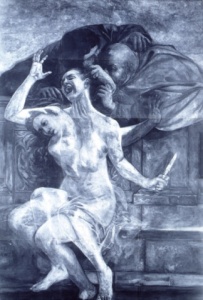“The Ecstasy of Saint Theresa” was created by Gian Lorenzo Bernini in 1652, and was commissioned by Cardinal Federico Cornaro. The piece still stands in Rome, Italy in the in the Cornaro Chapel of the Santa Maria della Vittoria church.
Bernini’s work was heavily influenced by the new wave of religious art inspired by the patronage of the Council of Trent. While this piece was not directly funded by the organization, he was commissioned to create an installation piece for the Cornaro Chapel by Cardinal Federica Carnaro himself. The piece depicts the newly canonized Saint Theresa, an odd choice for the time because of her questionable claims of religious ideology and spiritual experiences. She is shown in a state of rapture, her much recorded spiritual encounters in which she was overwhelmed by the love of God. This particular scene is thought to have been inspired by a particular passage from her writings:
“… Beside me, on the left hand, appeared an angel in bodily form… He was not tall but short, and very beautiful; and his face was so aflame that he appeared to be one of the highest rank of angels, who seem to be all on fire… In his hands I saw a great golden spear, and at the iron tip there appeared to be a point of fire. This he plunged into my heart several times … and left me utterly consumed by the great love of God. The pain was so severe that it made me utter several moans. The sweetness caused by this intense pain is so extreme that one cannot possibly wish it to cease, nor is one’s soul then content with anything but God. This is not a physical, but a spiritual pain, though the body has some share in it-even a considerable share …” (PBS).
The piece is huge and imposing, taking up not only and entire wall, but also the ceiling and walls perpendicular to the central focus as well. The piece is ornate, using sculpture, carving, painting, theatrical staging, as well as lighting to create an overwhelming product. The central figures as well as the on looking audience on the perpendicular walls are all incredibly expressive. They are positioned in movement with expressions of interest, or in Theresa’s case, ecstasy. Bernini’s background in theater leant greatly to his dramatic staging of the characters of interest. He positioned the central scene under the stained glass window, so that the chamber in which Theresa and the angel are positioned would light up as if from the light of a heavenly power from above, reflected on the gilded beams raining down upon them. His piece served the purpose of overwhelming the audience with the power of faith, inspiring a stronger worship of god through the depiction of heaven’s divine glory.
I, personally, enjoy the splendor of works like this. The entirety of the piece is simply awe inspiring. The attention to detail is incredible, creating expressive unique characters from marble, and crafting flowing robes from the stone.
The scene is framed perfectly, the contrasting dark marble around the scene creating the presence of a stage. The figures appear to be floating in the center focus, in a state of rapture between the darkened representation of Hell below, and the figurative light of heaven above. The religious symbolism involved in the piece, besides the obvious is astounding, such as the small detail of the dove, the representation of the holy spirit, painted towards the ceiling, near the window so that the light of heaven seems to shine down upon the figures from where it rests. The contrasts of light and dark stone, shadow and light around the very sculptures themselves, utilize not only the actual marble, but also the empty space around the stone to better illuminate the movement and expression of the figures.
Bernini, Gian Lorenzo. The Ecstasy of Saint Theresa. 1652. Sculpture. Santa Maria Della Vittoria, Rome, Italy.
“The Ecstasy of Saint Theresa.” Artble. N.p., 2015. Web. 22 June 2015. <http://www.artble.com/artists/gian_lorenzo_bernini/sculpture/the_ecstasy_of_saint_theresa>.
PBS. PBS, n.d. Web. 22 June 2015. <http://www.pbs.org/wnet/powerofart/berbios.php>.





